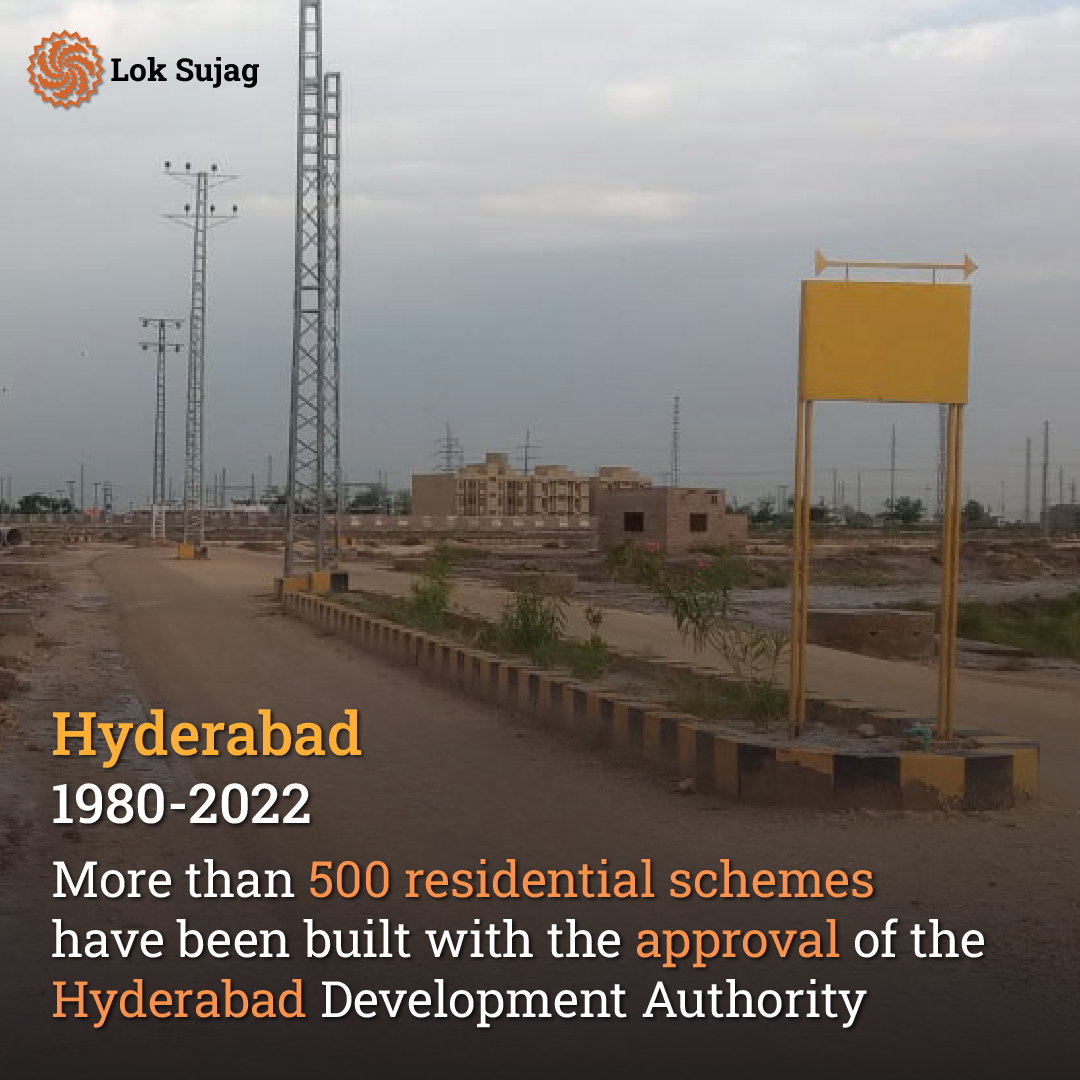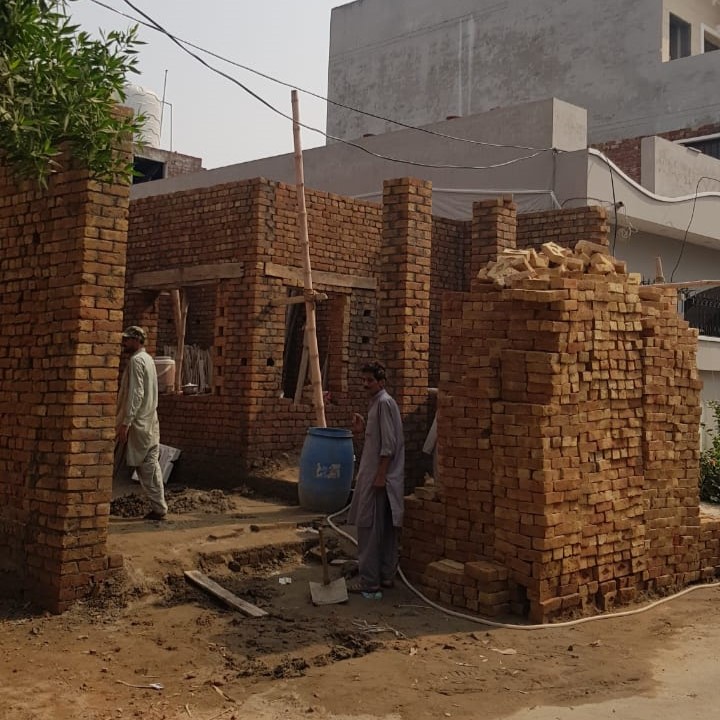Shama Kolhi, a forty-year-old woman, works as a labourer at the new vegetable market in Hyderabad. She is a mother of four children, and her husband is also employed in the construction sector.
She lives in the village of Lakhman Kolhi, three kilometres from the city and surrounded by beautiful palace-like houses. Their village, with a population of 500 people, has been established on Hala Naka Road for fifty years. Recently, a massive housing scheme has been developed on 300 acres of land in this region.
Shama recalls that there used to be mango, plum, and lemon gardens everywhere. Women and men worked together to grow crops like onion, sugarcane, tomato, and wheat. However, eventually, the landlords sold all the land to the builder.
“The gardens got destroyed, and when the crops vanished, people had to sell their cattle too. The underground water turned bitter, causing more difficulties. We not only lost our means of livelihood but also had to buy vegetables, milk, and water from the market.
“The builder’s employees ask us to leave the village every day. They want to demolish our houses as well. If we must be evicted, we request to be moved to a safe place to live without fear and continue farming.”

The population of Hyderabad city has almost reached 20 lakhs. Over 500 residential schemes have been constructed here between 1980 and 2023, all approved by the Hyderabad Development Authority.
Currently, dozens of residential colonies are still being constructed around the city, covering an area of approximately 1,000 acres. These include Vohra Town, Abbas Town, Bismillah Town, Qadir Avenue, Jumeirah Palm City, Hyderabad New City, Golden Town, Isra Village, and many others.
Due to the expansion of housing schemes, more than 20 small and large villages where people have lived for years are being vacated.
Around 19,000 people from villages like Umid Ali Laghari, Haji Bhatti, Sher Muhammad Gopang, Urs Alamani, and others face an uncertain situation. The farmers are now fighting their last battle to save their homes.
Omid Laghari, a village with 400 people, is part of the ‘Fazal Sun City’ housing scheme. Dost Ali, a social worker in this village, explains that the 300 acres of land for the housing scheme originally belonged to the Department of Finance (Revenue) and the Inhar Department. An Inhar engineer, Abdul Aziz Sheikh, obtained a 99-year lease for the agricultural use of this land. Later, with the approval of the Revenue Department, the land was sold. There was also a canal in the past, but it is now defunct, and plots are being developed there.

Ali Nawaz, a resident of Urs Alamani village, continues to do farming. He mentions that according to the Sindh Agrarian Law, a farmer cannot be evicted from the land without receiving a notice, but he has not received any notice until now.
Fifty-year-old Ali Nawaz supports a family of ten people all by himself. He shares that when the young boys from the village go to the city for work, they get detained by the Rahuki and Hatari police under the builders’ instructions.
“The officials threaten us to leave the village, or they won’t let us live in peace. We have to give bribes to free the boys when they are detained. This has happened twice.”
Mir Ijaz, a primary school teacher from the same village, mentions that four years ago, the owners of Hyderabad New City Housing Scheme, Arif Builders, filed a case against the local people for not vacating the village.
He says that Zahid Soomro, an ex-army officer, registered the case under the provisions of the Anti-Terrorism Act at the Rahuki police station. The case included 20 young people and farmers from the village, including Muhammad Urs Alamani, Khair Muhammad, Khuda Bakhsh, and Kausar.
“Arrests were made, and we fought the case in the civil court. Last year, the case was proven to be false. However, now the village’s sewerage has been blocked. When people raised their voices, two false cases were registered against them. The police came to their houses, and they are being threatened.”

The SHO of Rahuki police station, Atta Muhammad Kaka, acknowledges that he took action on the complaint. However, he denies that the police threatened any farmer.
Faraz Memon, the Vice Chairman of the Association of Builders and Developers (ABAD) Hyderabad Region, explains that builders constructed residential projects on agricultural land to accommodate people’s needs as the population grew in Hyderabad. He clarifies that no one has illegally occupied the land; instead, the landlords purchased the land.
He explains that they have obtained NOCs from all the concerned bodies, including Sindh Building Control Authority, Hyderabad Development Authority, and Town Planning. The housing schemes are being developed only after getting the maps approved.
Faraz also mentions that the builders owe the farmers no money. “If there are any liabilities, they will be on the landlords.”
The Revenue Sub-Registrar at the Commissioner’s Office Hyderabad explains that any landowner can apply to the Hyderabad Development Authority to convert agricultural land to residential. The application goes to the Deputy Commissioner, as their approval is necessary. The fee for approving a land map in Hyderabad is two lakh rupees per acre.

Three months ago, the Sindh government declared 300 housing societies illegal in the province, including 20 schemes in the Hyderabad district. However, the work in these schemes, such as Al Madinah City, Al Rahim City, Kohsar Green City, Ghousia Town, Kohsar Haven, Saiban Housing Scheme, and others, has not stopped.
Provincial Agriculture Secretary Ejaz Ahmed Mahesar agrees that the rapid construction of housing schemes on agricultural land may lead to food security problems.
He informs Lok Sujag that he had also discussed with the Chief Minister about formulating a policy to ban housing colonies on agricultural land, as currently, there is no such law in place. They plan to create a land policy and enact the necessary legislation in the future.
Also Read

Illegal housing societies: TMA-LDA wrangling makes life of lower-middle class houseowners miserable
Lali, a forty-five-year-old woman from the village of Lakhman Kolhi, also works in the vegetable market alongside Shama Kolhi. She lives in a mud house with her five children.
She mentions that her ancestors have been living here for decades. When they apply for an ID card, the NADRA officials ask for the electricity bill. However, there has never been gas and electricity in their area, so they don’t have any bills to show.
“Zamindars have always lived abroad. All the work was done by ‘Kumdars,’ but even those we voted for are not protecting us.”
According to school teacher Mir Ijaz, the field of ‘Dubai’ lies ten kilometres northeast of Hyderabad city. During the British army’s attempt to occupy Sindh, a fierce battle occurred here on March 24, 1843, with the locally ruling Talpur family.
The British army, led by General Charles Napier, fought against the Sindhi army commanded by Hosh Mohammad Sheedi. Hosh Muhammad fought bravely and was martyred in the battle. His slogan, ‘Morvison Par Sindh Na Deson,’ is still remembered by the people. The British general built a memorial at the battleground and a memorial for Shaheed Hosh Muhammad. The shrine of Martyr Hosh Muhammad is located nearby.
Mir Ejaz says that builders are now also considering this area for a future housing scheme.
Published on 24 Jul 2023




















